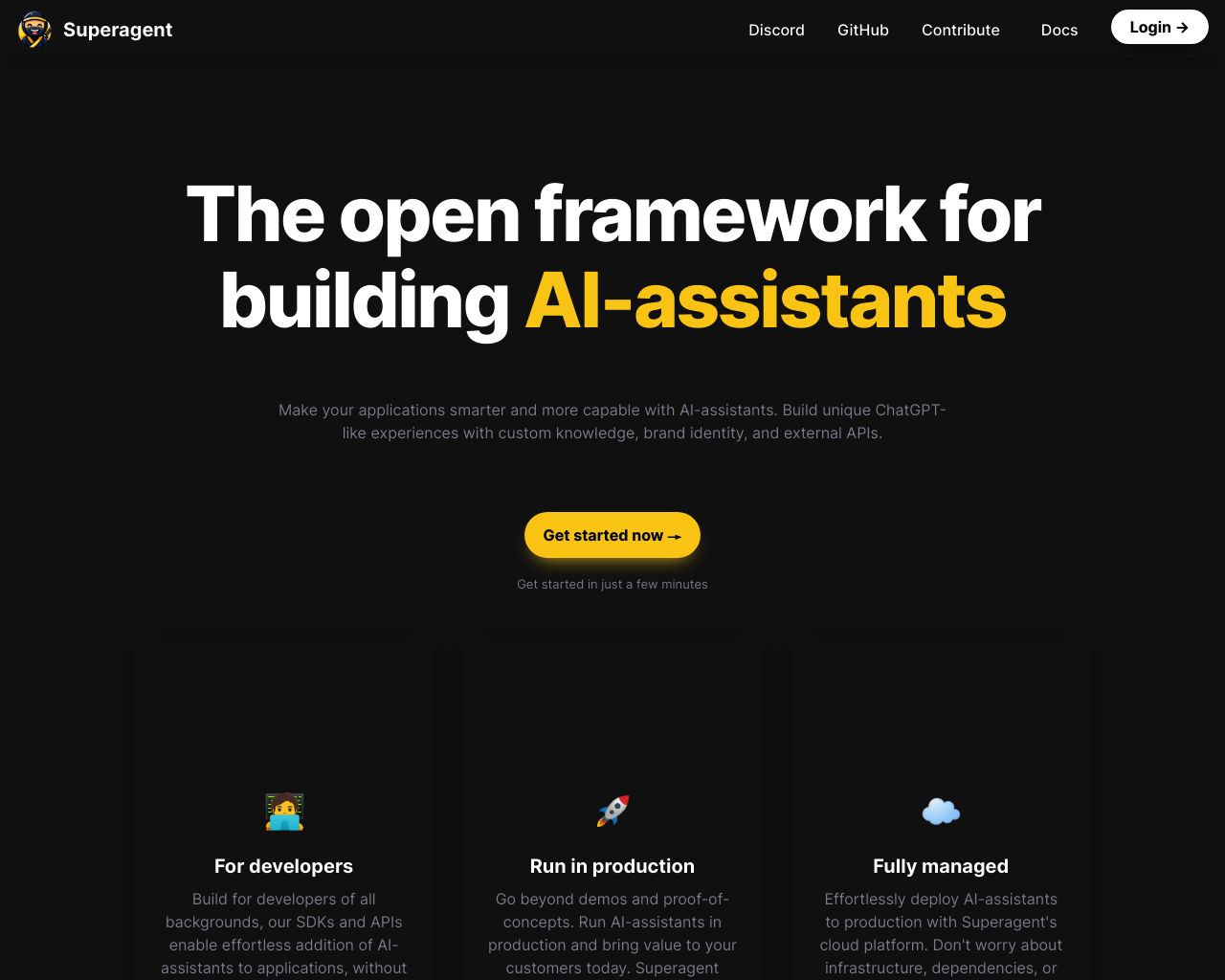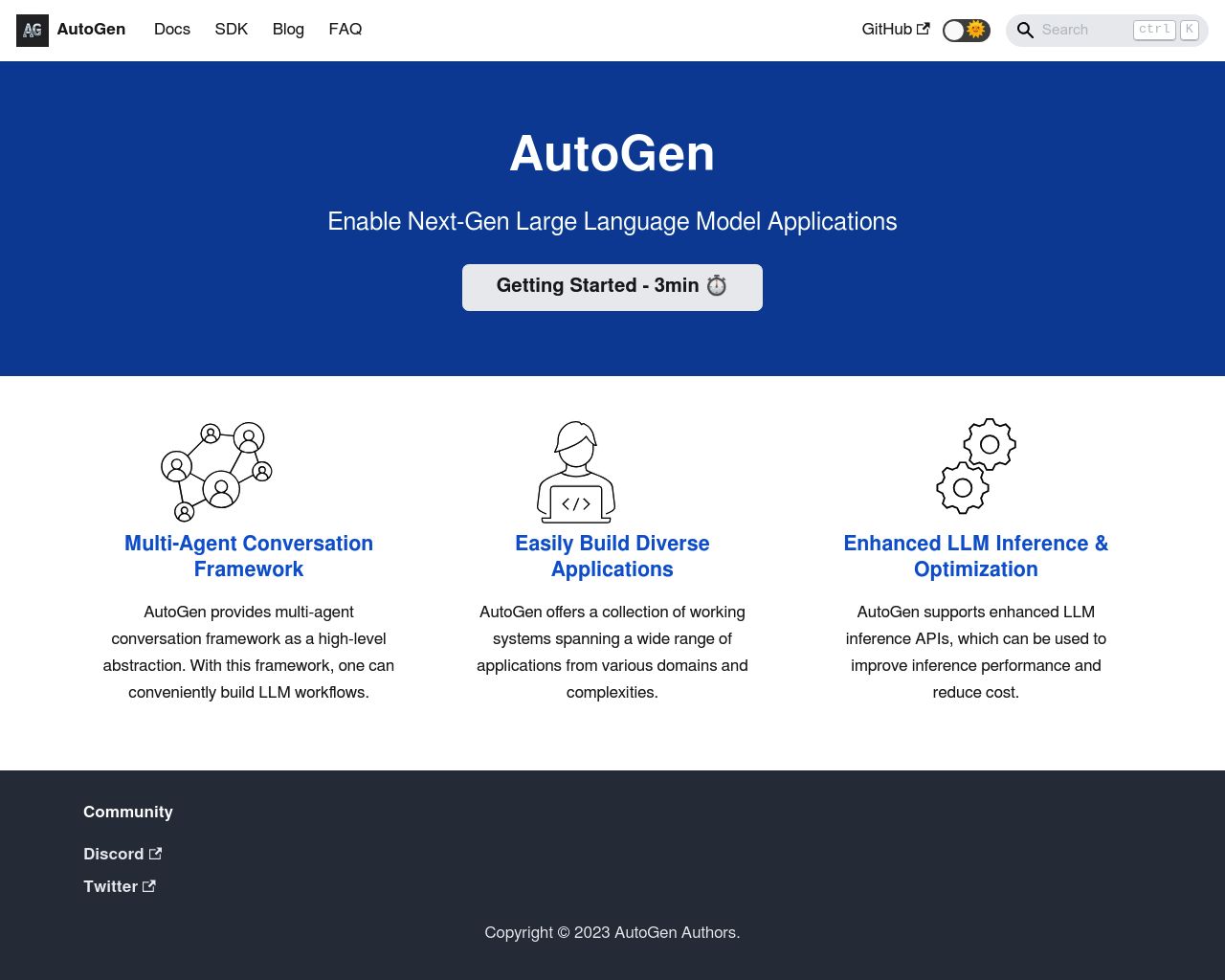Superagent And Autogen: A Comprehensive Comparison
AI agent development platforms revolutionize how businesses harness artificial intelligence, but choosing the right solution can be challenging. This comparison explores Superagent, AutoGen, and SmythOS, three leading platforms that offer unique approaches to AI agent creation and deployment. Superagent simplifies development with markup-based customization, while AutoGen excels in multi-agent conversations and LLM optimization. SmythOS, however, combines the best of both worlds with a user-friendly interface and powerful features. We’ll examine each platform’s strengths, limitations, and ideal use cases to help you make an informed decision for your AI development needs.
Superagent Overview
Superagent empowers developers to create, host, and manage AI agents without complex coding. This open-source platform streamlines the process of building custom AI solutions for web research, sales, marketing, and project management.
The software stands out with its simple markup customization, making AI agent creation accessible to non-experts. Superagent’s AI agents autonomously browse the web, access files, and seamlessly integrate with popular tools like Airtable, Salesforce, and various APIs. This versatility allows businesses to automate complex tasks traditionally requiring significant manual effort.
Superagent empowers developers to create, host, and manage AI agents without complex coding… making AI agent creation accessible to non-experts.
Superagent offers both local and cloud installations, catering to development and production needs. The platform equips agents with memory capabilities, enabling context-aware responses in interactions. For debugging, Superagent employs LangSmith to trace and refine agent performance. The software also supports vision capabilities through DALL-E integration, expanding its multimodal functionalities.


While Superagent excels in many areas, it lacks certain features found in more comprehensive platforms. The absence of a visual builder may pose challenges for users preferring graphical interfaces. Additionally, Superagent doesn’t explicitly mention features like multi-agent collaboration, explainability tools, or advanced monitoring capabilities.
Despite these limitations, Superagent’s focus on simplicity and integration makes it a compelling choice for businesses looking to leverage AI without extensive technical expertise. Its ability to deploy as a REST API further enhances its utility across various applications. Founded in 2023 and based in San Francisco, Superagent aims to democratize AI usage, making it practical for businesses of all sizes to transform their operations through intelligent automation.
AutoGen Overview
AutoGen empowers developers to build sophisticated Large Language Model (LLM) applications using multi-agent conversations. This open-source framework enables customizable agents to interact with each other, LLMs, tools, and humans to tackle complex tasks.


AutoGen’s core strength lies in facilitating multi-agent conversations. These agents work together autonomously or with human input, adapting to various use cases. The framework maximizes LLM performance through enhanced inference capabilities, including tuning, caching, error handling, and templating. This optimization proves crucial when working with resource-intensive models like GPT-4.
AutoGen empowers developers to build sophisticated Large Language Model (LLM) applications using multi-agent conversations.
Developers can tailor AutoGen’s agents to specific task requirements, integrating LLMs, human inputs, and various tools. The platform supports both fully autonomous operations and human-in-the-loop problem-solving, offering flexibility for applications where human oversight is essential.
AutoGen demonstrates effectiveness across diverse applications, from automated task solving and code generation to continual learning and complex problem-solving in group chats. For developers, it provides debugging tools and logging functionalities for API calls, essential for optimizing LLM-based systems. The inclusion of EcoOptiGen, a cost-effective technique for tuning large language models, underscores AutoGen’s focus on enhancing LLM efficiency and effectiveness.
AutoGen demonstrates effectiveness across diverse applications, from automated task solving and code generation to… complex problem-solving in group chats.
While AutoGen offers powerful capabilities, it may present a steeper learning curve for non-technical users compared to some visual builder platforms. Its focus on developer-centric features and flexibility could require more programming knowledge to fully leverage its potential. Additionally, as an open-source framework, enterprise-grade support and certain out-of-the-box integrations might be limited compared to some commercial alternatives.
Feature Comparison
Superagent and AutoGen offer distinct approaches to AI agent development, with notable differences in their core components and security features. Superagent excels in simplifying AI agent creation through its markup-based customization, making it accessible to non-experts. It provides robust integration options with popular tools and APIs, enabling seamless automation of complex tasks. However, Superagent lacks a visual builder, which may limit its appeal to users who prefer graphical interfaces for agent development.
AutoGen, on the other hand, stands out with its focus on multi-agent conversations and enhanced LLM inference capabilities. It offers powerful features for developers, including debugging tools and API call logging, which are crucial for optimizing LLM-based systems. AutoGen’s framework supports both autonomous operations and human-in-the-loop problem-solving, providing flexibility for various applications. However, it may present a steeper learning curve for non-technical users compared to Superagent’s simpler markup approach.
In terms of security, neither platform explicitly mentions advanced features like constrained alignment or comprehensive data encryption. This gap highlights an area where both could improve to meet enterprise-grade security requirements. While Superagent offers some basic security measures like OAuth and IP control, AutoGen’s documentation does not prominently feature security-specific functionalities, potentially raising concerns for users dealing with sensitive data or requiring strict compliance adherence.
Feature Comparison Table
| Superagent | AutoGen | SmythOS | |
|---|---|---|---|
| CORE FEATURES | |||
| Visual Builder | ❌ | ❌ | ✅ |
| No-Code Options | ✅ | ❌ | ✅ |
| Explainability & Transparency | ❌ | ✅ | ✅ |
| Audit Logs for Analytics | ❌ | ✅ | ✅ |
| Agent Work Scheduler | ✅ | ❌ | ✅ |
| SECURITY | |||
| Constrained Alignment | ❌ | ❌ | ✅ |
| IP Control | ✅ | ❌ | ✅ |
| COMPONENTS | |||
| Data Lakes | ❌ | ❌ | ✅ |
| DEPLOYMENT OPTIONS (EMBODIMENTS) | |||
| Staging Domains | ❌ | ❌ | ✅ |
| Production Domains | ✅ | ❌ | ✅ |
| Deploy as Scheduled Agent | ❌ | ❌ | ✅ |
| DATA LAKE SUPPORT | |||
| Hosted Vector Database | ✅ | ❌ | ✅ |
| Sitemap Crawler | ✅ | ❌ | ✅ |
| YouTube Transcript Crawler | ✅ | ❌ | ✅ |
Best Alternative to Superagent and AutoGen
SmythOS emerges as the superior alternative to Superagent and AutoGen, offering a comprehensive platform for AI agent development and deployment. We combine powerful features with unparalleled ease of use, making advanced AI capabilities accessible to users of all skill levels.
Our visual drag-and-drop interface sets SmythOS apart, allowing rapid agent creation without extensive coding. This intuitive approach accelerates development while maintaining flexibility for complex workflows. Unlike Superagent’s markup-based customization or AutoGen’s code-heavy framework, SmythOS empowers both technical and non-technical users to build sophisticated AI solutions.
SmythOS empowers both technical and non-technical users to build sophisticated AI solutions.
SmythOS excels in deployment options, supporting staging and production environments, scheduled agents, and integration with popular platforms. This versatility surpasses both Superagent and AutoGen, enabling seamless incorporation of AI agents into existing workflows and systems. Our platform also offers robust security features, including constrained alignment and comprehensive data encryption, addressing enterprise-grade requirements that competitors may overlook.
The SmythOS ecosystem provides a rich set of pre-built integrations, AI models, and data handling capabilities. Users can leverage our hosted vector database, multi-modal support, and advanced crawler functionalities to create AI agents that outperform those built with Superagent or AutoGen. These features, combined with our scalable architecture, position SmythOS as the ideal choice for businesses seeking to harness the full potential of AI across diverse applications and industries.
Conclusion
Superagent and AutoGen offer distinct approaches to AI agent development, each with unique strengths. Superagent excels in simplifying AI agent creation, making it accessible to non-experts through markup-based customization. AutoGen, on the other hand, provides powerful multi-agent conversation capabilities and enhanced LLM inference, catering to more technical users and complex applications.
While both platforms demonstrate effectiveness in various scenarios, they have limitations. Superagent lacks a visual builder, potentially hindering users who prefer graphical interfaces. AutoGen’s developer-centric approach may present a steeper learning curve for non-technical users. Additionally, both platforms have room for improvement in advanced security features and enterprise-grade support.
SmythOS emerges as the superior solution, addressing the limitations of both Superagent and AutoGen while offering a comprehensive suite of features. Our platform combines the ease of use of Superagent with the powerful capabilities of AutoGen, all within a user-friendly, drag-and-drop interface. SmythOS supports multi-agent collaboration, provides explainability tools, and offers advanced monitoring capabilities, making it suitable for users across technical skill levels.
With SmythOS, we’ve revolutionized AI agent development by making it 99% faster and more accessible. Our platform supports over 300,000 integrations, allows deployment across various environments, and includes robust security features like constrained alignment and data encryption. To experience the future of AI workforce automation, create a free SmythOS account today and start building AI agents with no time limit or risk.
Last updated:
Disclaimer: The information presented in this article is for general informational purposes only and is provided as is. While we strive to keep the content up-to-date and accurate, we make no representations or warranties of any kind, express or implied, about the completeness, accuracy, reliability, suitability, or availability of the information contained in this article.
Any reliance you place on such information is strictly at your own risk. We reserve the right to make additions, deletions, or modifications to the contents of this article at any time without prior notice.
In no event will we be liable for any loss or damage including without limitation, indirect or consequential loss or damage, or any loss or damage whatsoever arising from loss of data, profits, or any other loss not specified herein arising out of, or in connection with, the use of this article.
Despite our best efforts, this article may contain oversights, errors, or omissions. If you notice any inaccuracies or have concerns about the content, please report them through our content feedback form. Your input helps us maintain the quality and reliability of our information.
